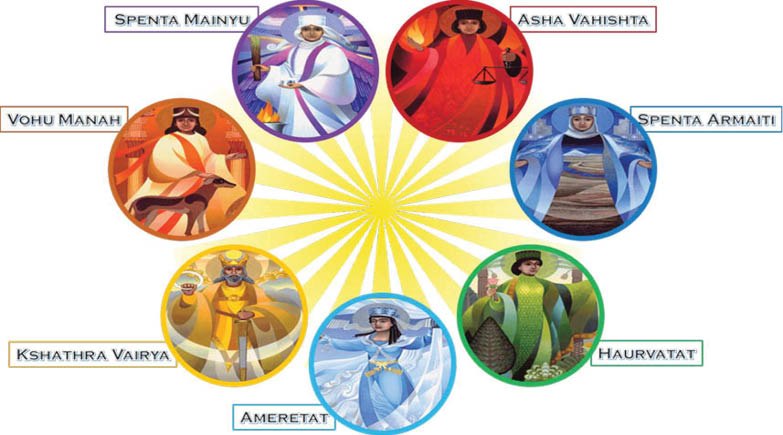[Representing FEZANA at the Parliament of World Religions – 2021]

There is nothing more important in life than life itself. This does not just refer to human lives, but all life forms; The well-being and future of all living beings are intertwined. Today, what we know as ecology, was taught by our prophet Zarathushtra, thousands of years ago! In order to achieve success in preserving, healing and sustaining our environment for the benefit of our current and future generations, we need to come together and use our good minds to form a collective consciousness.
In Zoroastrianism, there are 7 Amesha Spentas, bounteous immortals, each having a benevolent quality and a responsibility of overlooking each of the wonderful creations of God. This heptad (set of seven) is also considered as the seven steps or commandments, which when followed, benefits individuals and collectively – us all, to bring about progress in improving ourselves and others, in terms of physical and emotional health, as also prosperity and happiness.
The first Amesha Spenta is Spenta Mainyu, the beneficent spirit. The quality is innate Wisdom/God’s will and the creation looked after/represents is Human Beings. Hence, it is important that we realize God’s will by connecting ourselves with our superconscious through meditative prayers and caring for each other through wisdom.
The second Amesha Spenta is Vohu Manah – the good mind or the rational mind, which helps us make all our decisions. The creation being looked after is Animals. It is important that we use our good minds to further goodness in this world and also take care of animals. This tradition affects our environment and us – the output is in direct proportion to the inputs “Garbage in garbage out” what food you eat affects our (mental and physical health) thinking and disposition to a very great extent.
God gave us dominion over animals to take care of them, not harm them. Factory farming of animals creates more fossil fuels, pollutes our environment, and depletes natural resources more than any other industry. Hence, it is important that we transition to a healthy, plant-based diet that is good for our health and our environment.
The third Amesha Spenta – Asha Vahishta – looks after/represents Fire, which is the purest form of energy that is present in all living beings and the physical manifestation of that energy is the holy fire that we can physically see. It also represents the energy that is not visible to the human eye. Possessing the qualities of righteousness, truth, and order. It is important that we use renewable energy from natural and clean sources like Sun and Wind. It is also essential that we follow the path of righteousness by practicing truth and orderliness in our lives to bring about peace and happiness.
The fourth beneficent spirit is Kshthravairya which looks after the sky and metals. The quality possessed is of moral strength, power, and conviction. Here, we learn to care for birds who fly; and we also make the best use of metal objects. A knife in a surgeon’s hands can save a life and in a murderer’s hands can end a life. 0
Kshthravairya helps us not to give up; when you are treading the path of righteousness, you are bound to come across a lot of obstacles and distractions, and you need to gather courage, moral strength and conviction to overcome those obstacles and distractions.
The fifth is Spenta Armaiti – she looks after Mother Earth and has the qualities of holy piety, devotion, and love. Hence, it is crucial that we take care of our Mother Earth in the most loving way, and be devoted to the cause of taking care of our environment, and also invest feelings of love in all our work that we do on a daily basis.
Then we have the 6th step Haurvatat or perfection – She presides over the waters. We need to conserve water by reducing our use of natural resources, which are becoming scarce. Also, we must be mindful to not pollute water by using less plastic and more reusable items. Only about 10% of recyclable items around the world are recycled, the rest use landfills and eventually make their way into bodies of water, which is extremely harmful to marine life. The last of the heptad is Ameretat, who oversees the Plant kingdom and possesses the quality of immortality or long life. And that what is righteous will be remembered for long.
Thus, we become immortal through thinking good thoughts, speaking good words, and performing good deeds wherever we go. Our thoughts, words, and deeds affect not only ourselves, but the entire universe. We are as much a part of the universe as the universe is a part of us because God’s energy is present in all living beings and we all are made in the image of God. Until about 2 years ago, not many of us did not realize the importance of the air that we breathe and the fact that Plants give us this life-sustaining force throughout our lives. We took this for granted. Our lives depend on plants, hence we need to grow more plants (mainly trees). Furthermore, we must take care of our environment – with the 7 Ameshaspands in mind, as mentioned before – to revive our planet and secure the future for generations to come.
THE PLEDGE TO MAKE HEAVEN ON EARTH:
How about we make a pledge today to learn, practice and imbibe the qualities of these Amesha Spentas in our lives, namely the Wisdom, the higher consciousness, the superintelligence, the righteousness and order, the moral strength, the holy piety/devotion/love, Perfection and good deeds… all that would be helpful for our future generations! And also let us make a sincere effort to take better care of our environment and each other. Thus, we can create Heaven on Earth, starting now!
The Importance Of Nature In Zoroastrianism: Nature is an integral part of our Zoroastrian religion, we revere all the elements of our nature, and what we revere, we may use, but we must never misuse it or abuse it. Today what we know as ecology was taught to us by our prophet Zarathushtra thousands of years ago to take care of our environment. There are many prayers and rituals dedicated to nature. One of them – the Jashan ceremony – strengthens the particular element of nature that we pray to and also invokes the blessings of the divinity in charge of that particular element.
Jashan is a Pahlavi (old Persian) word that has its genesis from an Avestan word Yasna, which means religious service. In the Jashan ceremony, the representatives of the seven Amesha Spentas – the bounteous immortals, the deputies of Dadar Ahura Mazda are present: Spenta Mainyu, who looks after mankind is represented by the priests; Bahman Amshashpand or Vohu Manah – the Good Mind, who looks after the animal kingdom is represented by milk; Asha Vahishta or Ardibehesht Amshashpand looks after the fire and energy and are represented by fire; Kshthra Vairya or Sherevar Amhashpand looks after the sky, and all the minerals and metals and is represented by all the metal elements in the ceremony; Spenta Armaiti or Spandarmad Amshashpand, who looks after Mother Earth, is represented by the earth on which we sit and perform the ceremony; Haurvatat or Khordad Amshashpand, who looks after the waters is represented by the beaker of water placed in the ceremony; and Ameretat or Amardad Amshashpand, who looks after the Plant kingdom, is represented by the fruits and flowers placed in the Jashan ceremony.
God’s energy is present in all living beings and the physical manifestation of that energy is the holy fire. Fire is a very important element in Zoroastrian religion and it is present in all our ceremonies and rituals, the holy fire is also considered as a receiver and a transmitter, who receives the energy from the spirit world and transmits to His devotees who are present.
- દિકરી એટલે બીજી માં… - 20 April2024
- નાગપુરની બાઈ હીરાબાઈ એમ. મુલાનદરેમહેરનો ઇતિહાસ - 20 April2024
- વિશ્વ ભારતી સંસ્થાન દ્વારા રતિ વાડિયાનુંસન્માન કરવામાં આવ્યું - 20 April2024
